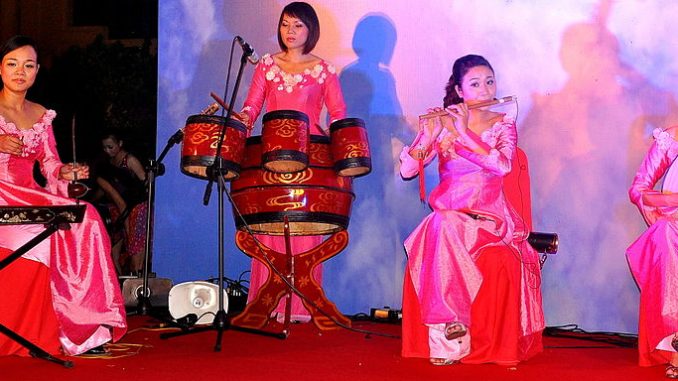
As members of a generation where entertainment is limited to either a night of binge watching Netflix or re-watching videos of past VMA performances on YouTube, it’s a rare and special day when young people and community members gather to fully immerse themselves in the performance and music of a foreign culture.
On Wednesday, Oct. 5, SUNY New Paltz students and faculty sat eagerly in their seats for a riveting demonstration and performance, titled “Music and Theatre of Vietnam.” Courtesy of the Anthropology Department, the event was another edition of the 2016-2017 Anthropology Department Lecture Series, a series dedicated to providing students with a more worldly experience.
The presentation kicked off under the direction of Truong Hoang Chuong, who is well versed in the nuances of Tuong Theatre. Chuong demonstrated the whimsical distinctions between the presentation of good spirited characters and characters he classified as “evil.” Chuong’s charisma and lightheartedness not only conveyed the caricature nature of the art but brought laughs and smiles to everyone in attendance. This art form includes the use of props and costume pieces, most specifically, wigs. The way a character brandishes these items is how the audience can decipher the character’s true intentions, according to Chuong.
Chuong’s performance was followed by a musical set from musician Mai Thi Tuyet Hoa, who demonstrated Hat Xam, a style of music in which was originally practiced primarily by blind musicians.
Hoa sang two songs; one was a classic folk tune, and the other was a ballad. The latter of the two told the story of a woman who was encouraging her husband to continue studying for his civil service exam so he can prove himself to be worthy of her. Hoa’s rendition of the tune held a warm and magical quality, utilizing vastly different vocal techniques than one might find here in the United States.
Hoa later went on to explain to the audience that she is one of the last people to know the ins and outs of this music genre, making the event that much more special, considering how many people are actually exposed to its charm is seemingly minimal.
Hoa’s performance was followed by the demonstration of how the Vietnamese utilize instruments to enhance the quality of jazz music. According to second-year computer engineering major Melvin Rodriguez, this portion was the highlight of the event.
“I enjoyed the incorporation of the modernization of Vietnamese jazz,” Rodriguez said.
The entire performance was translated and facilitated by assistant professor Lauren Meeker, who was “incredibly pleased with the number of people in attendance.” From the minute the performers filed into the room, it became abundantly clear that they were also pleased by the number of people who came to watch.
The energy in the air was palpable; audience members were intrigued by the foreign customs and rituals of Vietnamese performance and the performers were eager to entertain their audience. A balance of energies between audience and performer is quintessential regarding live theatre, and SUNY New Paltz was fortunate enough to witness masters of this trade.
First-year psychology major Rebecca Walsh said that she found the performance “mesmerizing.”
“The performers truly loved what they had been doing and the audience ate up every minute of it,” Walsh said.
Despite the watering down of the importance of Vietnamese folk performance, there is still a persistent minority who dedicate their lives to preserving the culture. If for only a short while, the event made the idea of “otherworldly experiences” feasible and enjoyable.
For more information regarding the event, students can reach Meeker at Meekerl@newpaltz.edu.
